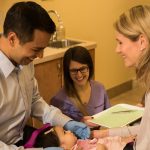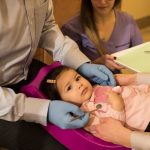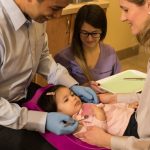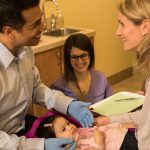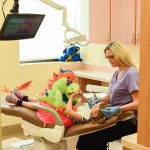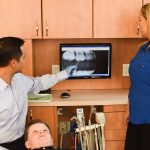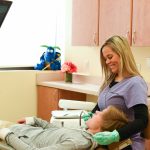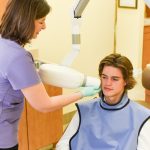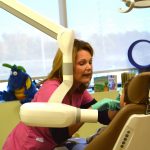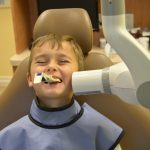Prevention & Education
Our goal is to prevent dental disease in your child by assessing their risk and tailoring an oral hygiene regimen that is reviewed at every check up. We guide every patient to optimal oral health by educating parent and child about diet and oral hygiene. Common risks for dental decay such as “grazing” or increased juice consumption are discussed. Brushing and flossing techniques are reviewed at every visit. Following a “Caries (Cavity) Risk Assessment”, a dental home care guide is reviewed and outlined with the child and parent.
Age 1 Dental Exam
- Baby Ava having her first dental exam
- First dental exam for Ava
- Michelle supports baby and parent
- Explaining findings of the exam…Great check up!
- Charlotte in Grandma’s lap
Check up Visit
- Bella learning how to brush on Dino
- Kerry cleaning Bella’s teeth
- Picking a toothbrush after the appointment..
- Selecting the perfect one
- Dr. V explaining x-rays
- Dr. K explaining x-rays
- Brittani demonstrating brushing and flossing technique to Ben
- Brittani cleaning Ben’s teeth
Why treat baby teeth?
Preventing infection
Dentistry for children is primarily done to prevent infection and pain which can be very serious. Treatment is often discussed from this perspective and risks for doing, postponing or not doing treatment is explored.
What is a Dental Home?
“The dental home is the ongoing relationship between the dentist and the patient, inclusive of all aspects of oral health care delivered in a comprehensive, continuously accessible, coordinated, and family-centered way. Establishment of a dental home begins no later than 12 months of age.”1
The Scientific Evidence on the Benefits of the First Dental Visit
The Canadian and American Academies of Pediatric Dentistry, the Canadian Paediatric Society and the American Academy of Pediatrics recommend that all children have their first dental visit during the first year of life. Providing early care to infants and their families allows for an opportunity to educate and inform parents about their children’s oral health. Parents are given counselling about infant oral hygiene, dietary counselling, caries risk assessment, home and office based fluoride therapies, and information relative to oral habits and dental injury prevention.1
Waiting for the first dental visit has many consequences
Dental cavities (caries) in children is the most prevalent disease of childhood, occurring 5 to 8 times more frequently than asthma! 2 National surveys in the US report that 41 % of children 2 to 11 years of age had cavities in their baby teeth and 42 % of children 6 to 19 years of age had cavities in their permanent teeth.3
Serious Health Problems, School Performance
Serious general health problems and significant pain, interference with eating, overuse of emergency rooms, and lost school time can result from cavities in children.7
School aged “children with poor ORAL health status were nearly 3 times more likely than their counterparts to miss school as a result of dental pain.5
Absences caused by pain were associated with poorer school performance however absences for routine check ups and treatment were not associated with poor performance.” Dental disease can also have systemic effects.4
There are several established links that have been found between oral infections caused by cavities and diabetes, heart disease, stroke, pre-term low birth weight babies. In addition to the link between oral and systemic health, oral health strongly influences quality of life and general well-being.
References
1. American Academy of Pediatric Dentistry. Infant Oral Health. Pediatr Dent 2000;22:82.
2. Oral Health in America: A Report of the Surgeon General. Rockville, MD: U.S. Department of Health and Human Services, National Institute of Dental and Craniofacial Research, National Institutes of Health; 2000.
3. Beltran-Aguilar ED, Barker LK, Canto MT, et al. Surveillance for dental caries, dental sealants, tooth retention, edentulism, and enamel fluorosis. MMWR Surveillance Summaries. 2005;54(3):1-44.
4. Edelstein BL, Maiorini E, Casamassimo PS, and Thikkurissy S, Beyond the dmft: The Human and Economic Cost of Early Childhood Caries J Am Dent Assoc 2009;140(6):650-657
5. Jackson SL, Vann WF Jr., Pahel BT, Kotch JB, Lee JY. The Impact of Poor Oral Health on Children’s School Performance Am J Pub Health 2011; February 17: e1-e7. doi:10.2105/ AJPH. 2010.200915.
Radiographs (x-rays)
- Showing Leo his x-rays
- Taking radiographs
- Ben gets bitewing x-rays taken
- Charlie preparing for a panoramic x-ray
- Tracy taking bitewing x-rays on Jayden
- Jayden loves being a great helper while taking x-rays
- Jayden is happy
- “Awesome Treasure Tower!”
Reversing Cavities
Demineralization of enamel or early cavities if identified are addressed by reviewing what they look like clinically and radiographically and ways to potentially reverse them are reviewed. Reversing cavities naturally and/or with remineralizing agents like Fluoride, Xylitol, Calcium, Phosphate is reviewed.
Facial Protection while playing sports and recreational activities
Mouth Guards
We would like to remind parents, coaches and athletes to play it safe when children and teens suit up for recreational and organized sports.
The face and mouth of a child or teenager can be easily injured if the proper precautions are not used while participating in sports or recreational activities. More than half of the 7 million sports- and recreation-related injuries that occur each year are sustained by children as young as 5 years old.1 In the US alone, it is forecasted that more than 3 million teeth would be knocked out in youth sporting events. Athletes who do not wear mouth guards are 60 times more likely to damage their teeth.1
Up to 84% of children do not wear mouth guards while playing organized sports because they are not required to wear them, even though they may be required to wear other protective materials, such as helmets and shoulder pads.2 Mouth guards can be one of the least expensive pieces of protective equipment available, they save teeth and they help protect the jaws.
An effective mouth guard covers and protects the teeth and gums, resists tearing and allows for normal speech and breathing. It should cover the teeth and possibly the gums depending on the patient’s bite.
The History of the Mouth Guard3
Initially used by professional boxers, the mouthguard has been used as a protective device since the early 1900s. The mouthguard, also referred to as a gumshield or mouth protector, is defined as a “resilient device or appliance placed inside the mouth to reduce oral injuries, particularly to teeth and surrounding structures.” The mouthguard was constructed to “protect the lips and intra-oral tissues from bruising and laceration, to protect the teeth from crown fractures, root fractures, luxations, and avulsions, to protect the jaw from fracture and dislocations, and to provide support for edentulous space.” The mouthguard works by “absorbing the energy imparted at the site of impact and by dissipating the remaining energy.”
Important tips:
Wear a mouth guard when playing contact sports. Mouth guards can help prevent injury to a child or teenager’s jaw, mouth and teeth. At Milton Pediatric Dentistry, we can make your child or teen a customized mouth guard, which will provide a customized fit. Other less-expensive options are the boil and bite mouth guards, which are softened in boiling water to fit the mouth, and stock mouth guards, which are ready-to-wear. These alternatives may not fit as well because they are not customized for your child’s mouth.
- Wear a helmet. Helmets absorb the energy of an impact and help prevent damage to the head.
- Wear protective eyewear. Eyes are extremely vulnerable to damage by UV rays, especially when playing sports.
- Wear a face shield to avoid damage to the delicate bones around the eyes, nose and jaw. Hockey pucks, hockey or lacrosse sticks, basketballs etc can cause severe facial damage.
References
1. Play it Safe: Prevent Facial Injuries With Simple Sports Safety Precautions. April 2013 AAPD statement
2 AAO 2009 Protective Sports Gear Survey. 3. AAPD Reference Manual V37/No6. 15/16

